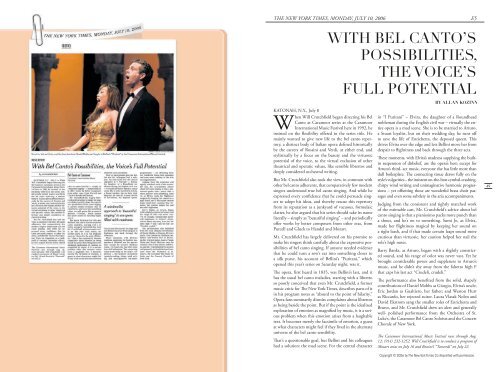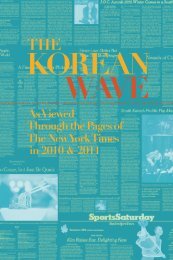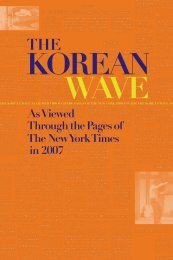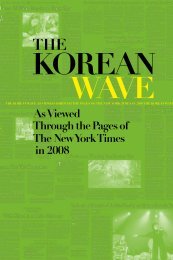The Korean Wave 2006 - Korean Cultural Service
The Korean Wave 2006 - Korean Cultural Service
The Korean Wave 2006 - Korean Cultural Service
You also want an ePaper? Increase the reach of your titles
YUMPU automatically turns print PDFs into web optimized ePapers that Google loves.
<strong>The</strong> New York Times, monday, july 10, <strong>2006</strong><br />
E5<br />
KATONAH, N.Y., July 8<br />
When Will Crutchfield began directing his Bel<br />
Canto at Caramoor series at the Caramoor<br />
International Music Festival here in 1992, he<br />
insisted on the flexibility offered in the series title. He<br />
mainly wanted to give new life to the bel canto repertory,<br />
a distinct body of Italian opera defined historically<br />
by the careers of Rossini and Verdi, at either end, and<br />
stylistically by a focus on the beauty and the virtuosic<br />
potential of the voice, to the virtual exclusion of other<br />
theatrical and operatic values, like sensible librettos and<br />
deeply considered orchestral writing.<br />
But Mr. Crutchfield also took the view, in common with<br />
other bel canto adherents, that comparatively few modern<br />
singers understood true bel canto singing. And while he<br />
expressed every confidence that he could persuade singers<br />
to adopt his ideas, and thereby rescue this repertory<br />
from its reputation as a junkyard of vacuous, formulaic<br />
clatter, he also argued that his series should take its name<br />
literally – simply as “beautiful singing” – and periodically<br />
offer works by better composers from other eras, from<br />
Purcell and Gluck to Handel and Mozart.<br />
Mr. Crutchfield has largely delivered on his promise to<br />
make his singers think carefully about the expressive possibilities<br />
of bel canto singing. If anyone needed evidence<br />
that he could turn a sow’s ear into something closer to<br />
a silk purse, his account of Bellini’s “Puritani,” which<br />
opened this year’s series on Saturday night, was it.<br />
<strong>The</strong> opera, first heard in 1835, was Bellini’s last, and it<br />
has the usual bel canto maladies, starting with a libretto<br />
so poorly conceived that even Mr. Crutchfield, a former<br />
music critic for <strong>The</strong> New York Times, describes parts of it<br />
in his program notes as “absurd to the point of hilarity.”<br />
Opera fans summarily dismiss complaints about librettos<br />
as being beside the point. But if the point is the idealized<br />
exploration of emotion as magnified by music, it is a serious<br />
problem when this emotion arises from a laughable<br />
text. It becomes merely the facsimile of emotion, a guess<br />
at what characters might feel if they lived in the alternate<br />
universe of the bel canto sensibility.<br />
That’s a questionable goal, but Bellini and his colleagues<br />
had a solution: the mad scene. For the central character<br />
With Bel Canto’s<br />
Possibilities,<br />
the Voice’s<br />
Full Potential<br />
By ALLAN KOZINN<br />
in “I Puritani” – Elvira, the daughter of a Roundhead<br />
nobleman during the English civil war – virtually the entire<br />
opera is a mad scene. She is to be married to Arturo,<br />
a Stuart loyalist, but on their wedding day, he runs off<br />
to save the life of Enrichetta, the deposed queen. This<br />
drives Elvira over the edge and lets Bellini move her from<br />
despair to flightiness and back through the three acts.<br />
<strong>The</strong>se moments, with Elvira’s madness supplying the builtin<br />
suspension of disbelief, are the opera’s best: except for<br />
Arturo’s third- act music, everyone else has little more than<br />
dull boilerplate. <strong>The</strong> connecting tissue draws fully on the<br />
style’s vulgarities – the insistent on-the-beat cymbal-crashing,<br />
chirpy wind writing and unimaginative harmonic progressions<br />
– yet offsetting those are wonderful brass choir passages<br />
and even some subtlety in the aria accompaniments.<br />
Judging from the consistent and tightly matched work<br />
of the estimable cast, Mr. Crutchfield’s advice about bel<br />
canto singing is that a pianissimo packs more punch than<br />
a shout, and he’s on to something. Sumi Jo, as Elvira,<br />
made her flightiness magical by keeping her sound on<br />
a tight leash, and if that made certain leaps sound more<br />
cautious than virtuosic, her caution helped her nail the<br />
role’s high notes.<br />
Barry Banks, as Arturo, began with a slightly constricted<br />
sound, and his range of color was never vast. Yet he<br />
brought considerable power and suppleness to Arturo’s<br />
music, and he didn’t shy away from the falsetto high F<br />
that caps his last act “Crudeli, crudeli.”<br />
<strong>The</strong> performance also benefited from the solid, shapely<br />
contributions of Daniel Mobbs as Giorgio, Elvira’s uncle;<br />
Eric Jordan as Gualtiero, her father; and Weston Hurt<br />
as Riccardo, her rejected suitor. Laura Vlasak Nolen and<br />
David Ekstrom sang the smaller roles of Enrichetta and<br />
Bruno, and Mr. Crutchfield drew an alert and generally<br />
well- polished performance from the Orchestra of St.<br />
Luke’s, the Caramoor Bel Canto Soloists and the Concert<br />
Chorale of New York.<br />
<strong>The</strong> Caramoor International Music Festival runs through Aug.<br />
12; (914) 232-1252. Will Crutchfield is to conduct a program of<br />
Mozart arias on July 16 and Rossini’s “Tancredi” on July 22.<br />
49<br />
Copyright © <strong>2006</strong> by <strong>The</strong> New York Times Co. Reprinted with permission.





